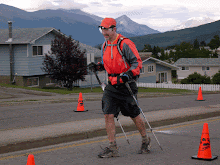Again, a brief cautionary tale that many runners can sympathize with.
For this one I will use another smart, highly-motivated, compulsive runner who also happens to be a physician.
At nearly fifty he, like me, dusted off his running shoes and started and illustrious career as a long distance tail runner… Until the nagging pain in his foot began to slow him down.
What did he do?
He ran more, of course. His social and reward systems had become attached to running and he was not willing to give them up.
To make a long story short, he ignored the pain until he could no longer take 50 steps without it becoming severe. At each juncture where his body told him “stop” he kept going.
This led to arthritis in a specific joint and eventually surgery.
After almost two years he is beginning to take a few short runs but still has pain.
It looks like my dear friend will be a great biking buddy.
Isn’t it kind of funny; it seems like so many runners wind up on bikes because they ignore their aches and pains until permanent damage is done.
Now I am not immune to this and have made the same mistakes very recently. A lot of this is in my book and more importantly how to avoid it but here it is nut a nutshell.
Your cardiovascular system (heart and lungs) is geared toward rapid improvements. You will take this as very positive feedback and well, you should because we are marvelous machines.
But our orthopedic system (muscles, tendons and bones) is nowhere near as fast to respond. There are a lot of physiologic reasons for this but here is a good rule of thumb.
What you can achieve heart and lung-wise in 2 to 3 months may take a year or more for your skeletal system to catch up with.
This is the reason people can go out and run 10 or 15 miles after 6 to
8 weeks of solid training say maybe 10 to 15 runs. And on the last run they develop a tendon, or muscular or worse yet, a bone problem that stops them dead in their tracks.
It’s also the reason why the recommended mileage increases are so much lower than it feels like they should be -- 5 or 10% every 2 to 3 weeks or less if you are going for ultra long distances.
At some point you will bump up against what I call your biomechanical monkey. That is the musculoskeletal system’s limitation (again, muscle, bone, joint or tendon) that makes you less than a perfect runner.
Unless you are one of the few lucky individuals who are truly “built”
for running, you will meet the monkey at some time.
Everyone has a distance or a speed or a combination of both that lets the monkey out of his cage to make mischief and wreak havoc with your training.
For some, it’s plantar fasciitis. For others, it’s IT band syndrome or shin splints or Achilles tendonitis or runners toe or any number of wonderfully complex sounding names that boil down to this: “too much too soon” or in some cases “that is as far as you should really be running!”
Now again, as one who has beaten some of the worst biomechanical monkeys in the book and done what most doctors told him not to do, I can tell you there are always ways around this stuff if you are truly willing.
Again that is in my book, but for now here it is:
Beware of the biomechanical monkey and pay attention to it as early as you can!!!
Otherwise it may be with you a lot longer than you want, maybe forever!
- Doc
Thursday, May 14, 2009
Subscribe to:
Post Comments (Atom)

No comments:
Post a Comment